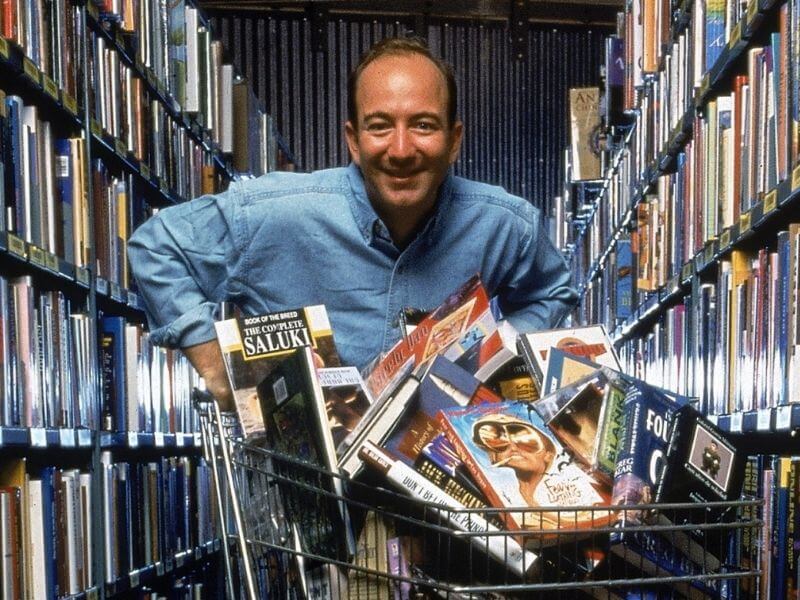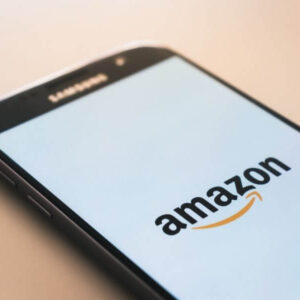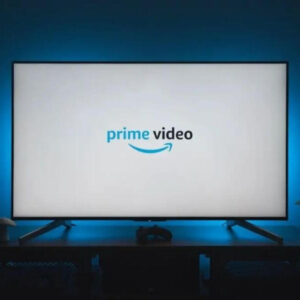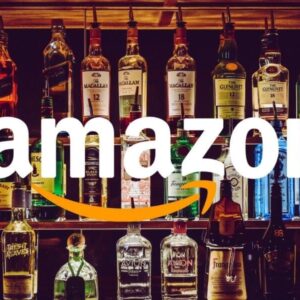Where did Amazon start? What made Amazon so popular? Ranking fifth in the world in terms of market cap with a staggering $1.045 trillion (CompaniesMarketCap, 2023), Amazon has been able to cement itself as a global giant that has altered how we shop and live. Expanding beyond just delivering goods, it is also a media streaming service and manufactures other technologies such as “Alexa”.
Amazon has quickly become one of the most recognizable company names throughout the world. It has achieved such success that it has become commonly used as a verb in everyday language, much like “Google.” However, like many other large corporations today such as Google and Facebook, Amazon started out as a small business building its way up to being a large corporation. Within this article, we’ll explore Amazon’s company history and its rags-to-riches story.

Where did Amazon start?
Amazon, or more correctly, Amazon.com, was first incorporated by Jeff Bezos in July 2005. At the time, he was a Wall Street hedge fund executive.
Amazon was originally to be called Cadabra (from Abracadabra). But Bezos’ lawyer advised him that the reference to magic might be a bit too obscure.
Also, when people heard the name on the phone, they often heard “Cadaver” instead — not ideal.
So, Bezos and his then-wife MacKenzie Tuttle started registering domain names for their potential new venture. Bezos soon registered the domain names Awake.com, Browse.com, and Bookmall.com. He also registered the domain name Relentless.com and kept it. If you type that into your browser today, you’ll be redirected to Amazon.com.
After scrolling through a dictionary for inspiration, he hit the word Amazon. Bezos thought this was particularly fitting as he envisaged his online store becoming the biggest in the world — much like the Amazon is one of the biggest rivers on the planet.
This is the philosophy behind why Amazon is commonly called the everything store today. Amazon.com was registered on the 1st of November 1994. Name sorted, but what to sell?
At the time, he knew he wanted to build some form of an online retailer but wasn’t sure what to sell. After some research, he settled on books. They were relatively easy to source, package, and distribute.
Amazon was not the first company to hit on this business strategy. Another company, Computer Literacy (a Silicon Valley bookstore), sold its wares online as early as 1991.
The difference that Amazon.com had to offer was its greater convenience. It, from the off, was based on a model of delivering online orders directly to the customer’s address anywhere in the world. As we all know, Amazon.com is about much more than just books today. This was always the plan, according to Bezos.
He contended from the company’s beginnings that Amazon was not just an online retailer selling consumer products. Bezos envisaged the company as a technology company whose real business was simplifying online transactions for its customers.
When did Amazon start selling things other than books?
As we have already seen, Amazon started out selling books online. This was groundbreaking for the time, and very few companies were providing the convenience that Amazon.com had to offer.
But, when did it start selling other products? After following Bezos’ initial business plan, the company expanded into selling computer games and music in 1998. Simultaneously, Amazon expanded its services internationally by purchasing other online bookstores in the UK and Germany.
By the turn of the Millenium, Amazon had further expanded into selling consumer electronics, video games, software, home-improvement items, toys, games, and much more. By the mid-2000s, Amazon had launched its Amazon Web Services (AWS). This innovation fitted well with Bezos’ initial ambition to make Amazon a tech company rather than an online retailer exclusively.
By 2006, Amazon expanded its AWS portfolio with its Elastic Computer Cloud (EC2). This was followed up by their Simple Storage Service (S3) soon after.
The company’s expansion into digital services like EC2 and S3 would boost the company’s revenues significantly. Today, they remain the bulk of the income for Amazon Web Services.
2007 saw the unveiling of the first Kindle e-readers. These relatively low-cost handheld tablets would invigorate the e-book market, and by 2012 the Kindle would constitute around 50% of all Android-operated tablet sales.
The Kindle’s success led to Amazon entering the e-book publishing market in 2011 with its Amazon Publishing service. That same year Amazon announced that e-book sales on its site were outselling traditional printed books. Since then, Amazon has continued to expand into many other services. These include shipping fresh produce, drone delivery, and many more innovations. Amazon has even recently begun operations at its very own airport.

When did Amazon start becoming popular, and when did Amazon go public?
Many of Bezos’ peers and other critics at its founding voiced their skepticism about his proposed business model. Financial journalists were some of the most vitriolic and often disparaged the company by referring to it as Amazon. Many claimed that Amazon.com would ultimately lose out to more established bookstores. Especially those that were already following suit and starting their e-commerce sites.
The very fact that Amazon.com didn’t become profitable until the final quarter of 2001 didn’t help things. But Bezos stayed firm and dismissed his naysayers as people who didn’t understand the business’s potential.
Bezos argued that to succeed as an online retailer; Amazon must “Get Big Fast.” And grow it did. By December 1996, the company’s customer base had grown to 180,000. By October of the year, this figure had leaped to around 1,000,000 registered accounts. Revenues had reached about $148 million in 1997, a significant jump from about $16 million in 1996.
Up until this point, Amazon had remained a private company. But Bezos soon realized he would need more than private investment to sustain the company’s growth.
And so, in 1997, Amazon.com went public and raised an eye-watering $54 million on the NASDAQ exchange. In addition to the cash, the company could use its stock sales to fund its aggressive growth and acquisition strategy.
By 1998, Amazon’s revenues had reached an impressive $600 million.
Amazon’s meteoric rise in such a short time frame catapulted Bezos into the public eye. He was also chosen to be Time magazine’s 1999 Person of the Year.
At around the same time, Amazon launched its now highly lucrative Affiliate program. By joining the program, other companies advertised Amazon’s merchandise on their platforms. Amazon would then fulfill the order and pay a commission — win, win. The program proved to be a savvy business decision. It grew from one Associate in 1996 to well over 350,000 by the close of 1999.
How does Amazon use technology to increase efficiency?
Apart from its near-universal appeal as a one-stop shop, Amazon has also taken advantage of the latest technological innovations to increase its efficiency and service to its customers. From using AI to handle and process orders or recruit to experimenting with drones and robots for order fulfillment and delivery, Amazon is certainly not afraid of testing out the latest innovation in tech.
This approach, however, has been both good and bad. For example, a machine-learning recruitment tool the company adopted was not used in the final decision process. It was later shown to have an apparent bias against certain groups of people for software developers and other technical positions. Once the issue was discovered, Amazon duly canceled the product.
Amazon has also adopted automated processes for firing as well as hiring. Such systems have been criticized for making decisions without being able to consider all factors — like issues in someone’s personal life, etc. Software solutions, like Amazon’s “Anytime Feedback Tool,” enable staff to praise or criticize their coworkers.
What made Amazon so popular?
The main appeal of Amazon in its early days was pure convenience. A potential customer no longer needed to visit a physical bookstore to get the book they were looking for. The ability to search, select and purchase a book from the comfort of your home was a fantastic innovation at the time. Also, Amazon would deliver your purchase to your front door within days.
The fact that they began to offer more and more different products only broadened its appeal to more and more customers. But it wasn’t really about the goods they were selling. Like many other successful companies, Amazon’s success is owed to the service they offer. This gained them significant customer loyalty, resulting in big profits in the long run.
Another innovation Amazon made for its customers was its recommended product function. By offering other products to upsell, based on the customer’s previous purchases, Amazon increased its revenue even more.
Adding customer reviews of products also helped foster a “customer community” that made the site and its wares more appealing to potential new customers.
In recent years, Amazon has reached new heights, like becoming the second-ever $1 trillion market cap company in history (Apple got there first, believe it or not). After announcing and canceling plans to build its second HQ in New York following political pressure, Amazon would see record growth during 2020.
With many people stuck at home during the pandemic, Amazon and other online retailers enjoyed a field day. The most recent major news in Amazon’s more than 25 years in business was the announcement that Bezos has decided to step down as the company’s CEO as of fall 2021. How the company will perform with Bezos not behind the wheel, is yet to be seen, but if past performance is anything to go by, it is bound to be highly successful.
That is unless calls to break up Amazon gain serious traction in the public eye. As they say, time will tell. In 2023, like many large tech companies, Amazon announced that it would reduce its staff numbers to save costs.
And that is your lot for today.
From its early days as an online bookstore to its present-day status as a tech behemoth, Amazon has redefined the retail industry and transformed how we consume goods and services. Through innovative strategies and constant experimentation, Jeff Bezos and his team have built a company that’s not just a marketplace but also a platform, a logistics powerhouse, and a significant force in the world of entertainment and media.
As Amazon expands into new markets and industries, its impact on the global economy and society will only continue to grow. The story of Amazon is far from over, and we can’t wait to see what comes next.

Above is information about Where did Amazon start? What made Amazon so popular? that we have compiled. Hopefully, through the above content, you have a more detailed understanding of Amazon start. Thank you for reading our post.








